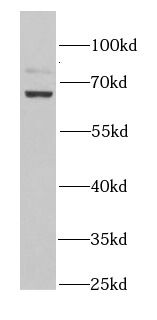Products
KLC1 antibody
Category:
Research Area:
- SPECIFICATIONS
- Product Name
- KLC1 antibody
- Catalogue No.
- FNab04594
- Size
- 100μg
- Form
- liquid
- Purification
- Immunogen affinity purified
- Purity
- ≥95% as determined by SDS-PAGE
- Clonality
- polyclonal
- Isotype
- IgG
- Storage
- PBS with 0.02% sodium azide and 50% glycerol pH 7.3, -20℃ for 12 months (Avoid repeated freeze / thaw cycles.)
Immunogen
- Immunogen
- kinesin light chain 1
- Alternative Names
- KLC antibody, KNS2 antibody
- UniProt ID
- Q07866
- Observed MW
- 66 kDa
Application
- Tested Applications
- ELISA, WB, IHC, IF
- Recommended dilution
- WB: 1:500 - 1:2000; IHC: 1:50 - 1:200; IF: 1:50 - 1:200
Validated Images
 mouse brain tissue were subjected to SDS PAGE followed by western blot with FNab04594(KLC1 antibody) at dilution of 1:1000
mouse brain tissue were subjected to SDS PAGE followed by western blot with FNab04594(KLC1 antibody) at dilution of 1:1000
 Immunohistochemistry of paraffin-embedded human brain tissue slide using FNab04594(KLC1 Antibody) at dilution of 1:100
Immunohistochemistry of paraffin-embedded human brain tissue slide using FNab04594(KLC1 Antibody) at dilution of 1:100
 Immunofluorescence analysis of U2OS cells using FNab04594(KLC1 antibody) at dilution of 1:100
Immunofluorescence analysis of U2OS cells using FNab04594(KLC1 antibody) at dilution of 1:100
- Background
- Conventional kinesin is a tetrameric molecule composed of two heavy chains and two light chains, and transports various cargos along microtubules toward their plus ends. The heavy chains provide the motor activity, while the light chains bind to various cargos. This gene encodes a member of the kinesin light chain family. It associates with kinesin heavy chain through an N-terminal domain, and six tetratricopeptide repeat (TPR) motifs are thought to be involved in binding of cargos such as vesicles, mitochondria, and the Golgi complex. Thus, kinesin light chains function as adapter molecules and not motors per se. Although previously named "kinesin 2", this gene is not a member of the kinesin-2 / kinesin heavy chain subfamily of kinesin motor proteins. Extensive alternative splicing produces isoforms with different C-termini that are proposed to bind to different cargos; however, the full-length nature and/or biological validity of most of these variants have not been determined.



